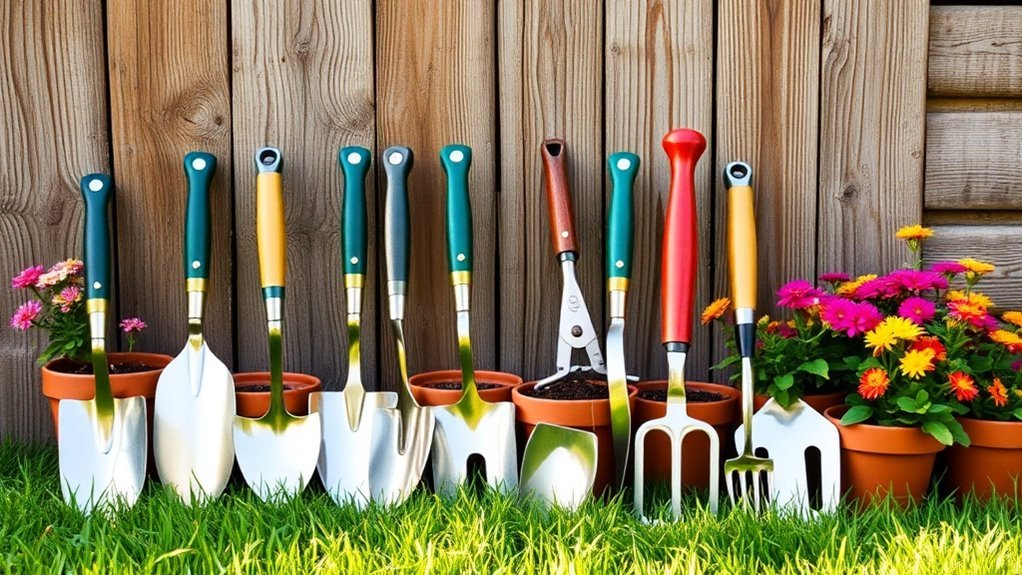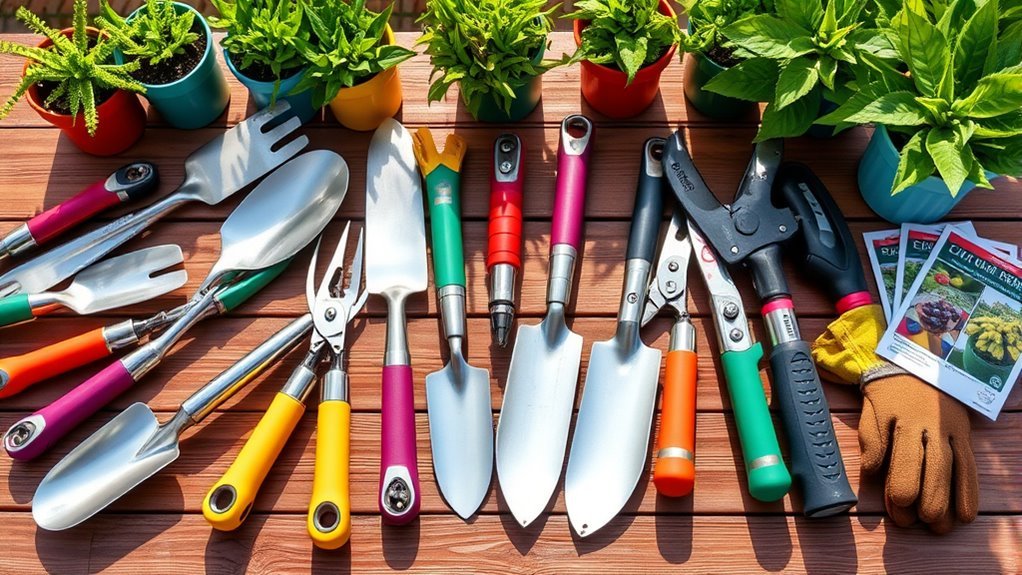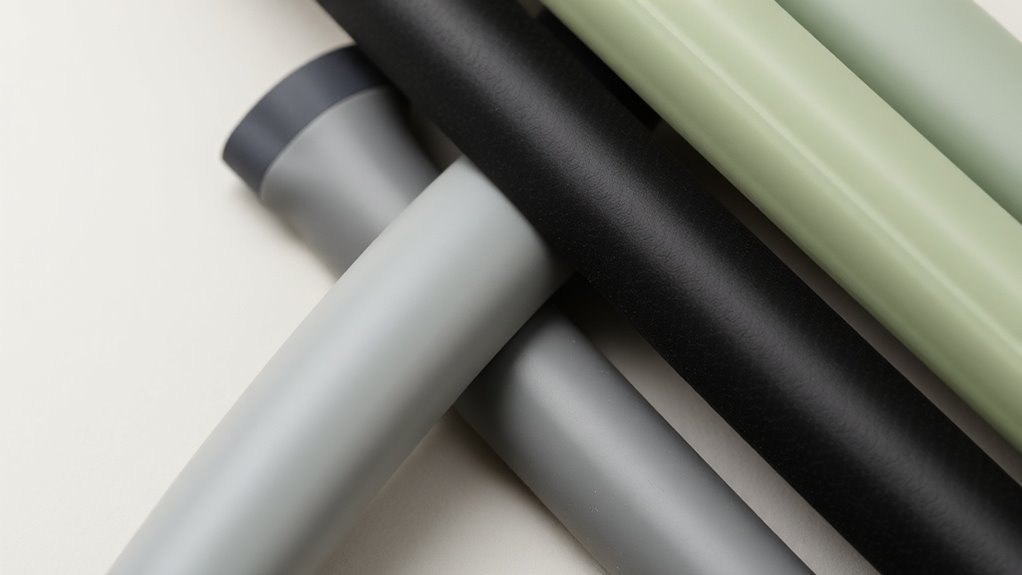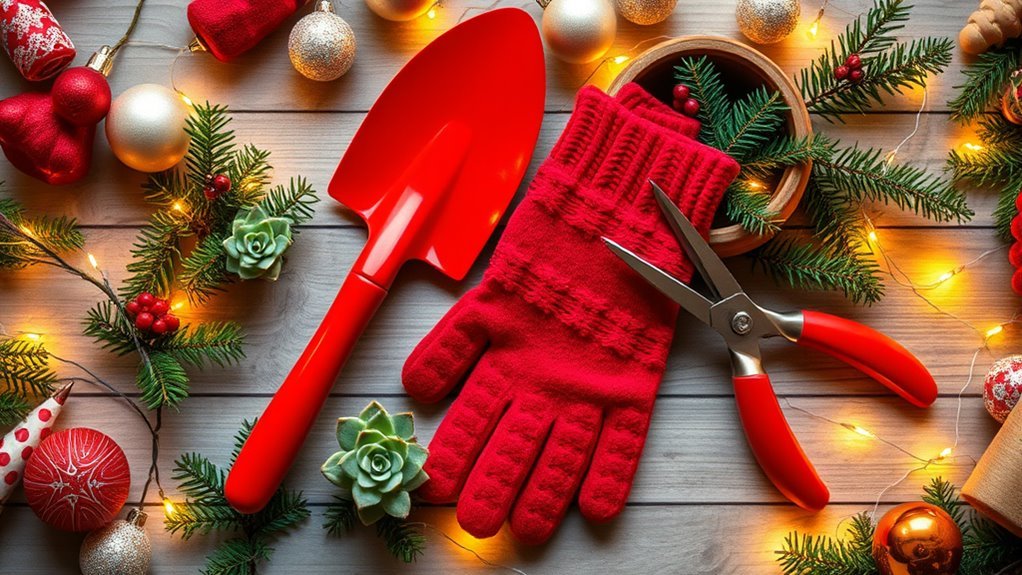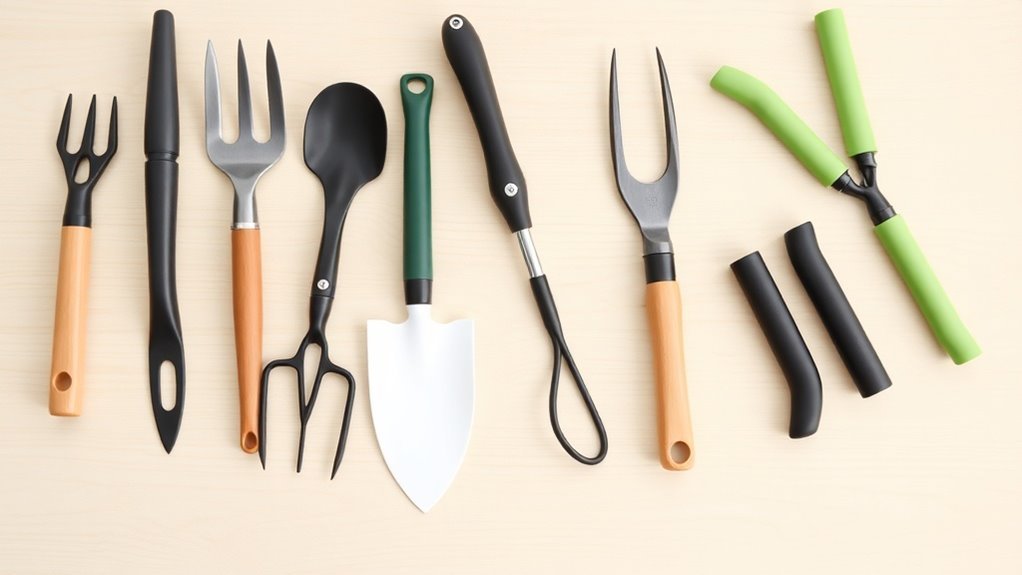The Mechanics of Pruners and How They Cut Cleanly
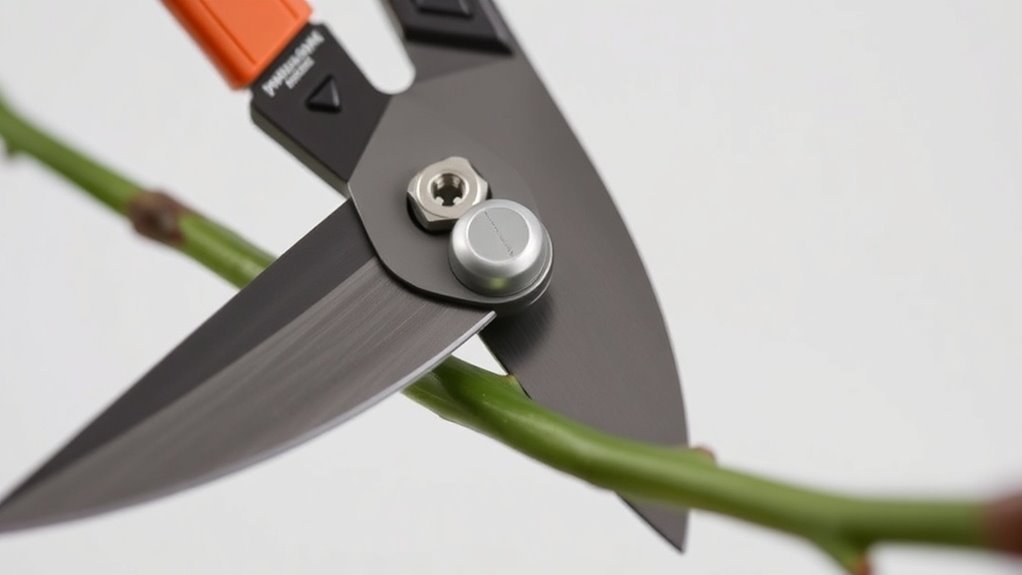
Pruners cut cleanly through plants by using sharp blades and a pivot mechanism that maximizes cutting power with minimal effort. Bypass pruners act like scissors, making clean cuts on live plants, while anvil pruners crush tougher wood. The blade’s angle of attack reduces tearing, helping plants heal faster. Regular maintenance, including sharpening and lubrication, keeps your pruners effective. Explore further to discover more about how to choose and maintain the right pruners for your gardening needs.
Key Takeaways
- Bypass pruners utilize a scissor-like mechanism for clean cuts on live plants, reducing damage and promoting quick healing.
- The pivot mechanism transfers force efficiently, allowing for easier cutting and enhancing the overall effectiveness of the tool.
- Sharpness is crucial; dull blades can tear plants, leading to stress or disease, while clean cuts encourage rapid healing.
- Anvil pruners support stems during cutting, reducing compression damage and ensuring a cleaner cut on dead or thick wood.
- Proper maintenance, including regular sharpening and lubrication, keeps blades functional, maximizing cutting precision and overall gardening success.
Understanding Pruners: Types and Designs
When you’re choosing pruners, it’s essential to understand the different types and designs available.
There are two main categories: bypass and anvil pruners. Bypass pruners work like scissors, featuring a curved blade that bypasses a straight blade, making them ideal for cutting live plants. They offer a clean cut, promoting plant health.
Bypass pruners provide a clean, scissor-like cut, making them perfect for maintaining the health of live plants.
On the other hand, anvil pruners have a single blade that cuts against a flat surface, which is better for dead or thick wood. They can crush stems, so keep that in mind.
Additionally, you’ll find manual versus powered options. Manual pruners rely on your strength, while powered ones offer assistance, making pruning easier for extensive tasks.
Choosing the right type depends on your gardening needs.
The Anatomy of a Pruner: Essential Components
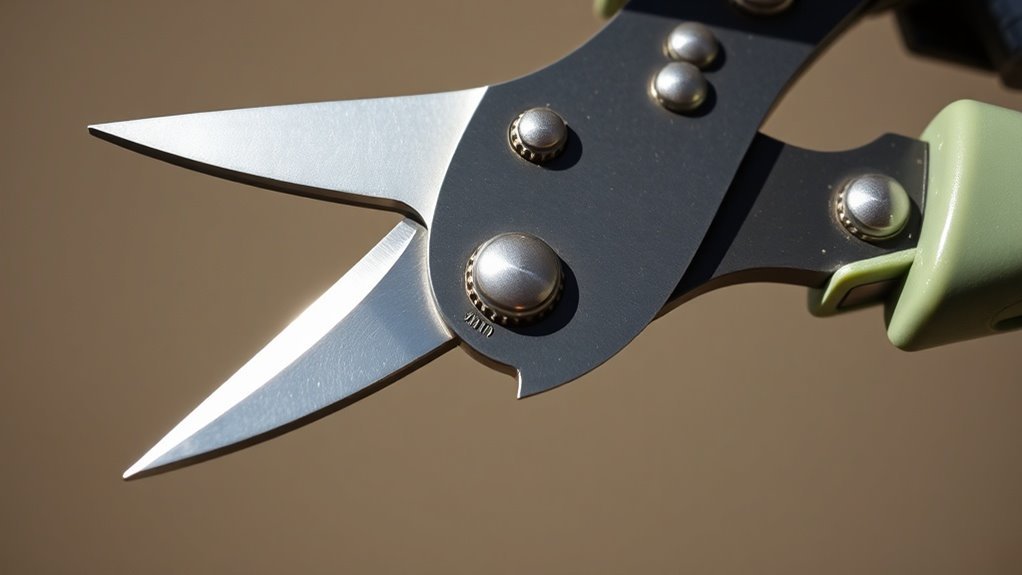
When you pick up a pruner, it’s important to understand its key components. The cutting blade design, pivot mechanism function, and handle ergonomics all play a critical role in how effectively the tool performs.
Let’s explore these elements to see how they contribute to clean cuts and ease of use.
Cutting Blade Design
The cutting blade design is essential for achieving clean cuts, as it directly impacts the efficiency and health of your plants. A well-designed blade can make all the difference when pruning, helping you tackle even the toughest branches with ease.
Here’s what to look for:
- Sharpness: A sharp edge slices through stems effortlessly, minimizing damage and encouraging quick healing.
- Curvature: The right blade shape allows you to cut at different angles, ensuring access to those hard-to-reach spots without straining your wrist.
- Material: High-quality steel blades resist dulling and corrosion, providing lasting performance through multiple seasons.
With the right cutting blade design, you’ll maintain your garden’s vibrancy and promote healthy growth.
Pivot Mechanism Function
While many may overlook it, the pivot mechanism is vital for a pruner’s effectiveness, as it directly influences the tool’s cutting power and ease of use.
This intricate part acts as the fulcrum around which the blades rotate. When you squeeze the handles, the pivot transfers that force to the blades, allowing for a clean cut. A well-designed pivot mechanism minimizes the effort required to slice through branches, making your task easier and more efficient.
The positioning and durability of the pivot are significant, as they guarantee smooth operation and longevity. If the pivot is poorly crafted or worn out, you might struggle with cuts, leading to frustration and an ultimately ineffective pruning experience.
Handle Ergonomics Consideration
Although often overlooked, handle ergonomics are essential for ensuring comfort and efficiency during pruning tasks. The right handle can make all the difference, allowing you to prune for longer without hand fatigue.
Here are three features to evaluate:
- Grip Fit: A comfortable grip that suits your hand size prevents slipping and encourages a firm hold.
- Material: Rubberized or textured materials can enhance comfort while absorbing vibrations, making each cut easier on your hands.
- Angle: An angled handle helps maintain a natural wrist position, reducing strain and improving your cutting technique.
When choosing pruners, pay attention to these ergonomic features. They’ll not only improve your pruning experience but also enhance your overall effectiveness.
How Pruners Create a Clean Cut

Pruners create a clean cut by employing a precise cutting mechanism that minimizes damage to both the plant and the tool itself. The unique design features sharp blades that slice through stems, reducing tearing and bruising. This precision promotes healthier growth and recovery for your plants. Maintaining essential tools in good condition can further enhance their effectiveness and longevity.
| Feature | Benefit | Importance |
|---|---|---|
| Sharp Blades | Clean cuts without tearing | Reduces plant stress |
| Anvil Design | Supports the stem while cutting | Enhances cutting efficiency |
| Ergonomic Handles | Comfortable grip for extended use | Prevents hand fatigue |
| Adjustable Tension | Customizes cutting force | Guarantees peak performance |
| Lightweight Build | Easy to maneuver | Increases usability |
The Physics Behind Cutting Action
Understanding the physics behind cutting action reveals why pruners are so effective in maintaining plant health. When you clamp down on a branch, three essential forces come into play:
- Leverage: The longer the handles, the more force you can apply with minimal effort, making cuts easier.
- Shear Force: As the blades move across each other, they slice through plant material by applying pressure at the edge, promoting clean cuts.
- Angle of Attack: The design of the blade guarantees it enters the branch at an ideal angle, allowing for a smooth penetration and reducing tearing. Additionally, using durable cutting tools can enhance your gardening experience by ensuring that your pruners remain effective over time.
Choosing the Right Pruner for Your Needs
To achieve ideal cutting efficiency and promote plant health, it’s crucial to select the right pruner suited to your specific gardening needs.
Consider the types of plants you’ll be working with: bypass pruners are perfect for live branches, while anvil pruners are better for dead wood. If you’re tackling thick branches, a lopper might be more appropriate.
Comfort is key, too—ensure the pruner fits well in your hand and isn’t too heavy. Additionally, look for features like a locking mechanism for safety and a non-slip grip for better control.
Finally, think about the size and reach of the pruner to accommodate various tasks without straining your wrists. Ergonomic tool design can significantly enhance your gardening experience, making your tasks more enjoyable and efficient. Choosing wisely will make your gardening experience more enjoyable and efficient.
Maintenance Tips to Keep Your Pruners Sharp
To keep your pruners in top shape, you’ll want to focus on regular sharpening techniques and proper cleaning. A little lubrication can go a long way in ensuring smooth cuts. Additionally, regular maintenance such as checking for rust can prevent deterioration and enhance the life of your tools. Let’s explore how these simple maintenance tips can enhance the performance of your tools.
Regular Sharpening Techniques
Regularly sharpening your pruners is crucial for achieving clean cuts and promoting plant health. Dull blades can tear plants, leading to disease and stress.
Here are three effective techniques to keep your pruners sharp:
- Use a sharpening stone: Hold the blade at a 20-degree angle and slide it along the stone, applying even pressure. Repeat until you see a shiny edge.
- Try a round file: For curved blades, a round file is perfect. Work it along the edge in a circular motion, guaranteeing you maintain that same 20-degree angle.
- Employ a honing guide: This tool helps you maintain the correct angle while sharpening. It can make the process more straightforward and consistent.
Keeping your pruners sharp guarantees a healthier garden!
Cleaning and Lubrication
While keeping your pruners sharp is essential, cleaning and lubricating them is just as important for peak performance.
After each use, wipe down the blades with a clean cloth to remove sap, dirt, and debris. This prevents buildup that can impair cutting efficiency.
Once they’re clean, apply a few drops of oil to the pivot point and along the blades. This reduces friction and keeps your pruners operating smoothly.
Don’t forget to check for rust and apply vinegar or rust remover if needed. Proper maintenance not only extends their life but also enhances your cutting precision.
Best Practices for Using Pruners Effectively
Using pruners effectively can make a significant difference in the health of your plants and the ease of your gardening tasks. Here are some best practices to keep in mind:
- Make Clean Cuts: Always aim to cut at a 45-degree angle. This helps the plant heal faster and prevents water from pooling on the cut surface.
- Don’t Overreach: Position yourself close to your target branch. Overreaching can lead to uneven cuts and increase the risk of injury.
- Use Proper Technique: Hold your pruners with a firm grip, and squeeze gently but steadily. This guarantees clean cuts without damaging nearby tissue.
Questions
How Often Should I Replace My Pruners?
You should replace your pruners every few years, or sooner if they’re damaged or struggle to cut cleanly. Regular maintenance can prolong their life, but knowing when to replace them is essential for effective gardening.
Can I Use Pruners for Types of Plants?
Sure, you can use pruners on various plants. Just remember, if you’ve pruned too much, you might need a plant psychiatrist. Seriously, they’re great for shrubs, perennials, and even some trees—just don’t overdo it!
What Safety Features Do Modern Pruners Have?
Modern pruners typically have features like safety locks, ergonomic handles for better grip, and blade guards. These enhancements help prevent accidents, ensuring you can prune effectively while minimizing the risk of injury during your gardening tasks.
Are There Eco-Friendly Pruner Options Available?
Yes, you’ll find eco-friendly pruner options available that use sustainable materials, like recycled metals or biodegradable components. It’s like pruning your garden while nurturing the planet—each cut contributes to a greener future.
How Do I Properly Store My Pruners?
To properly store your pruners, clean them after use, applying a light coat of oil to prevent rust. Keep them in a dry, cool place, ideally in a sheath or tool drawer to avoid damage.
Conclusion
In conclusion, understanding your pruners is key to achieving clean cuts, choosing the right design enhances your gardening experience, and maintaining sharp blades guarantees peak performance. By recognizing the mechanics at play, you empower yourself to prune effectively and confidently. So, invest time in selecting the perfect tool, care for it diligently, and practice your technique regularly. With these steps, you’ll transform your pruning tasks from a chore into a rewarding part of your gardening journey.

